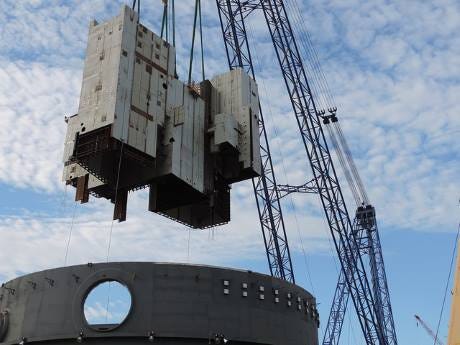Vogtle Revisited, or the Follies of Incremental Nuclear Ponzi Funding
As previously covered, the construction of Vogtle’s nuclear plants 3 & 4 was notorious for its cost overruns. Its excessive construction and capital costs made nuclear power in the U.S. look intractable in the face of cheap, plentiful natural gas.
Supposedly, its downfall was heightened regulations, mismanagement, new technology, and force majeure events like the pandemic, the Fukushima disaster, and the bankruptcy of its original owner—Westinghouse. Struggles with cost overruns and overly optimistic timelines that get pushed back because of first of a kind (FOAK) innovative technology have been a feature of nuclear projects for decades.
But even those explanations might not make sense as to why it was eight years past due and billions over budget.
The constant complaint of nuclear construction—excessive regulations—might have been at its worst with Vogtle when the Nuclear Regulatory Commission (NRC) mandated that the project prepare for a natural disaster like a September 11th-like airline crash. When the Fukushima earthquake struck in 2011, it made nuclear safety a priority, not unlike the Three Mile Island incident 33 years earlier.
The NRC required modifications to the design of the AP1000’s shield building in 2009, and eventually the design was approved in February of 2012. As of 2010, it was still expected to be delivered within its deadline between 2016 and 2017 and within budget. By 2015, it was only $1 billion over budget—not bad considering that it would eventually be at least $10 billion over budget when completed.
But if anything it was the collapse of Westinghouse’s other nuclear project in South Carolina, the Virgil C. Summer nuclear generating station, that would bring Westinghouse into bankruptcy in 2017, dragging Vogtle, down with it, and perhaps revealing why Vogtle was a boondoggle as well.
Otherwise known as Nukegate, it was very similar to Vogtle and other nuclear projects—overly ambitious timelines that were repeatedly pushed back, which drove up capital costs and complicated construction management. When the project ran late, they no longer qualified for $1 billion in government tax credits.
Different from Vogtle, it all ended with the project being scuttled and $9 billion spent with nothing to show for it despite having installed a 1,089 ton CA01 super module at its center with one of the largest heavy lift derricks in the world.
Eventually an SEC investigation would bring charges of securities fraud and a $5 million settlement against the utility, SCANA (South Carolina Electric & Gas Company), that included criminal charges for two SCANA and one Westinghouse executive for defrauding investors over their unrealistic financial and completion projections.
Blame partially went to the passage of the state’s Base Load Review Act, which allowed the project to be funded incrementally through increases to ratepayer bills on an as-needed basis after an approval. Depending on who you asked, the incremental funding and approval process either opened up the possibility for unchecked spending and incompetence or stymied the project with constant production halts while management decisions were debated in front of the public utilities commission that determined funding.
More than that, as part of Westinghouse’s bankruptcy filing one of the project’s investors, Citigroup, would accuse Westinghouse of much more than excessively optimistic financial prospects, but a litany of corruption.
According to the bankruptcy filing, the Summer construction project operated as a de facto Ponzi scheme where “[Westinghouse] would divert the cash advances from new AP1000 projects to fund work on existing AP1000 projects” as the company had been collecting undisclosed losses for years.
Phantom invoices were used to fake activity while the project was chronically understaffed. Work was scheduled just enough to feign activity and obtain payments. The follies of constructing and planning the reactors were beset by “delays in obtaining regulatory approvals, extensive and repeated design changes, and [Westinghouse’s] failure to ensure that critical components were timely constructed.”
For Vogtle, there were no accusations of phantom invoices and missing employees but instead accusations that there were too many workers at the same time running into each other.
A litany of testimony before Georgia Public Service Commission would accuse the project of being unnecessary, overly optimistic in its timelines, flooded with management mistakes, and construction issues requiring rework, but it’s hard to determine if these were the hallmarks of corruption or the standard foibles of managing a complex megaproject:
• Complex and congested rebar installations;
• The impact of late design and design changes;
• Delays due to late identification of QC issues;
• High rework rate;
• Poor quality of structural sub-modules making fit up difficult and time consuming;
• Late delivery of structural sub-modules;
• Failure to close work packages in a timely manner;
• Late licensing amendment requests by the Company so that construction in the field is consistent with the design basis.
With a modular design, parts of the AP1000 were produced elsewhere and shipped in from places like Japan and South Korea causing delivery delays, and there were quality issues from parts coming from a facility in Lake Charles, Louisiana similar to issues with Nukegate.
In May, Westinghouse, its current Canadian owner Brookfield, and the Trump administration announced a new initiative to fund $80 billion worth of nuclear reactors in the U.S. in exchange for 20 percent stake of cash distributions.

